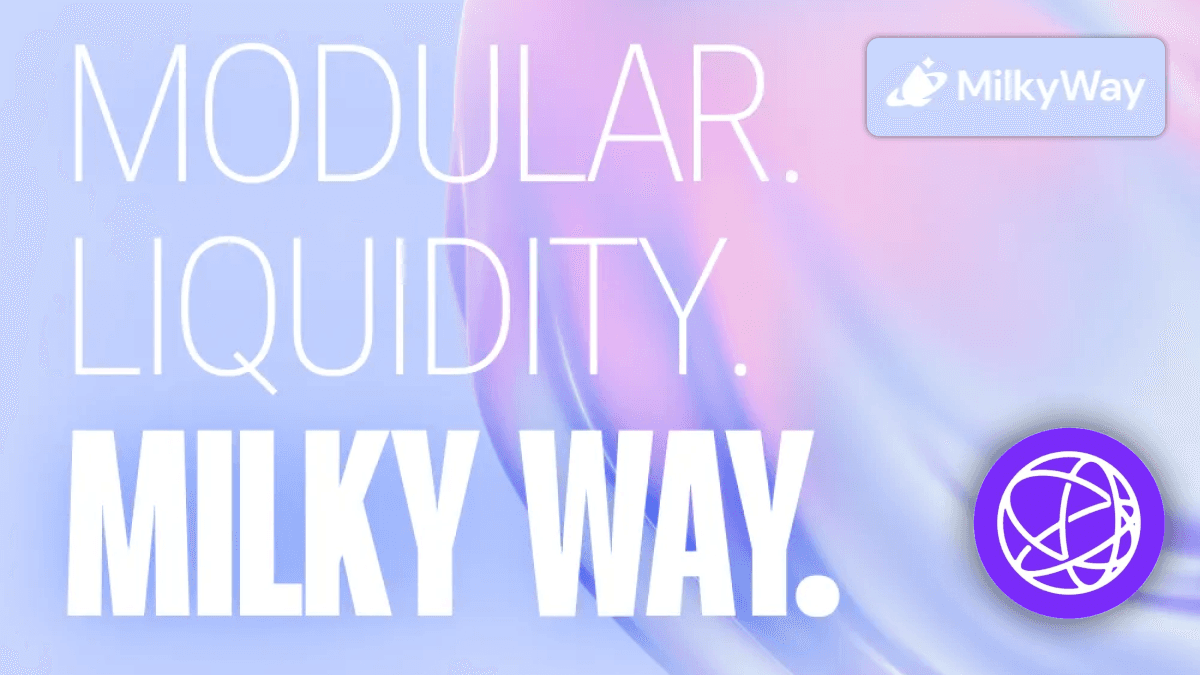Step into the MilkyWay, a Celestia liquid staking protocol.
Enter a galaxy where staking is modular, interchain, liquid, and kinetic. Just as the MilkyWay is the keystone of our celestial view, TIA staking is the keystone of the vibrant modular ecosystem.
This article is originally from MilkyWay’s Medium, which can be found here.
What is Celestia?
Celestia is a modular blockchain that provides a secure and scalable foundation for decentralized applications (dApps). It does this by separating the consensus and data availability layers from the execution layer. This allows Celestia to focus on providing a secure and efficient way to store and order data, while leaving the execution of transactions to other blockchains. You can learn more about Celestia here.
What is liquid staking?
Liquid staking enables users to stake their native tokens without the need to lock them up for a specific period of time. This is accomplished by providing users with a liquid token in exchange for their staked tokens. The liquid token can then be used in various DeFi applications, including lending and borrowing. When users want to withdraw their tokens instantly, they can do so by swapping the liquid token for the native token on a decentralized exchange (DEX).
Benefits of liquid staking include:
- Liquidity and Flexibility: Liquid staking allows token holders to earn rewards and participate in network security while retaining the flexibility to trade or use their staked assets at any time, eliminating the need to choose between staking for APR and participating in DeFi activities.
- Improved Network Security: Liquid staking encourages more token holders to stake their assets, enhancing overall blockchain network security.
- Capital Efficiency: Liquid staking is a more capital-efficient solution for blockchain projects and DeFi applications, as they don’t need to compete with the native staking yield.
Why is liquid staking important in Celestia?
Liquid staking comes in different flavors. From the smart contract-based Lido to the interchain account-based Cosmos ecosystem liquid staking services, each liquid staking provider has built an optimized architecture for the ecosystem it serves. There is no one-size-fits-all solution when it comes to liquid staking.
Celestia is unique in that it separates the execution layer, where complex programs like liquid staking applications typically run, from the consensus and data layer. The Celestia consensus layer does not support smart contract execution or interchain accounts. This makes it challenging to use pre-existing liquid staking architecture for Celestia.
This could be a problem. Liquid staking solves the problem where the base token (in this case, TIA) should be staked to secure its ecosystem, but also sees demand as ‘collateral’ and ‘money’ in DeFi applications that offer yield which may be higher than the staking reward.
The importance of staking in Celestia is greater than other typical appchain ecosystems. The consensus layer not only secures its own chain, but also many applications that use the base chain as the data availability layer to secure the applications they build. For Celestia to maintain a healthy equilibrium between maximizing tokens being staked and TIA being used in DeFi, a liquid staking protocol needs to emerge.
How will the MilkyWay protocol work?
Enter MilkyWay, a novel liquid staking protocol designed to bridge this gap. It leverages a fusion of CosmWasm contracts, multisig custody system and the Cosmos SDK authz module to introduce liquid staking derivative for Celestia ecosystem on the Osmosis blockchain.
A CosmWasm staking contract on Osmosis facilitates TIA deposits (stTIA issuance) and withdrawals, along with the claiming of TIA with accrued staking rewards. The interaction between the staking contract and Celestia is facilitated by the MilkyWay daemon, an off-chain program responsible for monitoring IBC transfer transactions originating from Osmosis. It also listens to relevant events on both Osmosis and Celestia and assists MilkyWay operators in verifying and signing IBC and staking transactions, ultimately generating a multi-signed transaction by aggregating signatures from the operators. We will share detailed information about how it works at a technical level soon.
To oversee and validate this process, MilkyWay will initially launch with nine trusted validators comprising of Stake.fish, Everstake, Chorus One, Allnodes, 01node, DSRV, Cosmostation, Hex Trust, and Keplr, whom collectively secure $5.86 billion across ecosystems such as Ethereum, Cosmos Hub, Osmosis, and many more. The number of validators in MilkyWay will increase as the staking pool grows.
What can stTIA be used for?
- DEX Liquidity: A TIA/stTIA pool on Osmosis will be created at launch to facilitate liquid staking.
Other possible use cases:
- Lending: Collateral in lending protocols such as Mars Protocol and Umee.
- Staking derivatives: Create staking derivatives such as stakers’ baskets and leveraged staking positions.
- Perpetual trading: Trade perps on platforms such as Levana and dYdX.
- Payment for Blobspace and gas on Celestia with stTIA: Chains and applications developed on Celestia will use TIA to access Celestia’s data availability by submitting transactions with PayForBlobs and as a method of payment for gas fees. Should Celestia choose to incorporate stTIA as a means of payment for both gas and data availability, this alignment will foster improved chain security. Chains will no longer have an incentive to forgo staking to ensure TIA availability for data availability and gas transactions.
Some of the above usage were originally proposed by Stride in this forum post.
What are the economics of the MilkyWay Protocol?
MilkyWay Protocol will charge a 10% fee on all staking rewards generated by stTIA holders. This fee will be held in a treasury contract. It will be used to fund development, provide incentives to users and validators, act as insurance to compensate stakers in the event of slashing, and support the Celestia ecosystem.
Will the MilkyWay Protocol have a token?
MILK will be the native token of the MilkyWay Protocol. MILK holders will receive a portion of the 10% protocol fee charged on all staking rewards generated by stTIA holders. MILK will also be the governance token of the MilkyWay Protocol, meaning that MILK holders will have the power to vote on changes to the protocol, such as new features, fee structure, and treasury management.
The MilkyWay Protocol is committed to being 100% governed by a decentralized autonomous organization (DAO). This means that the community will have full control over the protocol and its future.
How secure is the MilkyWay Protocol?
The security of the MilkyWay Protocol is of utmost importance, and it is ensured through a diligent approach:
- Thorough Testing and Auditing: Before its launch, the smart contracts and off-chain programs used in MilkyWay will undergo comprehensive testing and meticulous auditing.
- Open Source Code: We value transparency. The protocol’s code will be made openly accessible, allowing experts and the community to review and improve it collaboratively. This openness enhances security through collective scrutiny.
- An Experienced Team: MilkyWay is powered by a team of seasoned blockchain professionals, including individuals from Tendermint, Osmosis, Cosmostation, Crescent, Oak Security, Composable Finance, Crypto.com.
What does the roadmap of the MilkyWay Protocol look like?
V1 in Q4 2023
- Launch the MilkyWay application for users to liquid stake their TIA. More details coming soon!
After the V1 launch, we plan to raise a seed round to scale the team and expand the product suite. Our upcoming milestones include:
- Converting stTIA into a fully native liquid staking derivative is our next focus in development. In V1, stTIA will be issued on the Osmosis chain due to technical limitations. After V1, our primary focus is to migrate the issuance of liquid staking assets from the Osmosis chain to the Celestia rollkit. This transition is crucial for enhancing the scalability and security of liquid staking on Celestia.
- Launch the MILK token, the native token of the MilkyWay Protocol. MILK holders will receive a portion of the protocol fee charged on all staking rewards generated by stTIA holders, and will also have governance rights over the protocol.
- Launch the MilkyWay Protocol DAO. The DAO will be responsible for governing the protocol, including setting fees, managing the treasury, and developing new features.
- Enable liquid staking governance so stTIA holders will be able to vote for Celestia governance proposals.
- Promote the adoption of stTIA across other ecosystems, such as Ethereum and other roll ups to enhance stTIA’s liquidity and accessibility.
Stay tuned and follow us to keep up to date on further posts about MilkyWay’s upcoming launch details.
Or if you are interested in any potential partnerships, DM us on X and we will be in touch.




